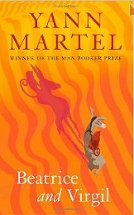Beatrice and Virgil by Yann Martel

Text Publishing, 2010.ISBN 9781921656255.
(Ages 16+) Recommended. Henry, the protagonist in this novel by Yann
Martel, author of The Life of Pi, has written a novel about the
Holocaust. When it is rejected by his publisher, he stops writing,
except to answer his readers' letters. He thus comes into contact with
an elderly taxidermist who seeks Henry's advice about his own writing.
The taxidermist's play concerns two animals, Beatrice, a donkey, and
Virgil, a howler monkey, which in a Becket-like dialogue reveal their
friendship and suffering. Juxtaposed to the play is the Flaubert short
story 'The Legend of Saint Julian the Hospitator', in which Julian is
described cruelly slaughtering thousands of animals until he
kills his own parents, an event predicted by one of his animal victims.
At first the taxidermist's play seems to be about the suffering
inflicted on animals by humans, but eventually it becomes clear to
Henry and the reader that the play is an allegory about the Holocaust
and the two animals, which always speak intelligently and with great
dignity, represent its many victims. It becomes clear too that the
taxidermist bears a burden of guilt when he himself appears in the play
as the boy who finally brutally kills both animals. Henry realizes that
the taxidermist is seeking redemption but rejects him, and unlike Saint
Julian who is elevated to heaven after atoning for his crimes against
humans, the taxidermist is immolated in a holocaust of his own making.
Though simply written, the novel draws on many classical and literary
texts to illuminate its meaning. Beatrice and Virgil were Dante's
guides through Hell in L'Inferno and the taxidermist means his
animals/characters to be understood as such for him. While they exist
as stuffed animals in his shop in his play they do not act like
animals, unlike the animals in The Life of Pi. They have the
same kind
of helpless companionship in the face of suffering that Vladimir and
Estragon have inWaiting for Godot. Destruction is a theme of the
novel
but it is also in part about the act of creation, and the difficulty of
using words to create meaning. Henry is forced to think about his own
writing when his novel is rejected. He helps the taxidermist with
suggestions, until he sees this as an act of complicity. The
taxidermist describes both his own attempts to write and the art of
taxidermy, which consists of taking the 'real' dead animal apart and
building a 'new' one that is not subject to the constraints of
time. Henry's experience with the taxidermist lead to his first
writing for some years, the story of Beatrice and Virgil that is a
celebration of life despite the tragedy.
While Beatrice and Virgil does not have the appeal of The
Life of Pi
senior students and teachers will find much to discuss, and to compare
with other recent writing about the Holocaust.
Jenny Hamilton